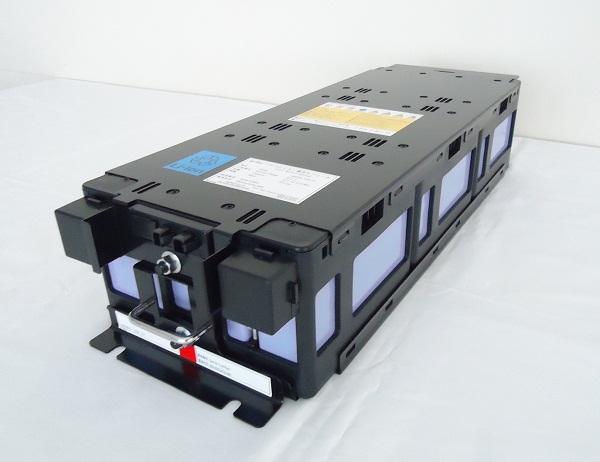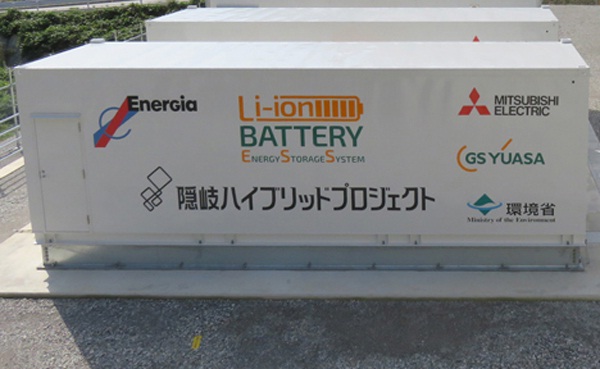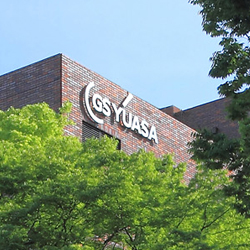GS Yuasa Corporation (Tokyo Stock Exchange: 6674; “GS Yuasa”) has delivered a 1,350kWh* container lithium-ion battery system to the newly established Nishinoshima Transformer Station of Chugoku Electric Power Co., Inc. (Tokyo Stock Exchange: 9504; “Chugoku Electric Power”) in Oki-gun, Shimane Prefecture. On September 30, operations of the system were commenced, and an opening ceremony was held today to celebrate the completion of system installation.
Nishinoshima Transformer Station was newly established for a storage battery system feasibility project for the purpose of measures against power output fluctuation required for the further introduction and expansion of renewable energy. The system being built for this feasibility project is a hybrid storage battery system which uses two different types of storage batteries, namely lithium-ion batteries and NAS (sodium-sulfur) batteries. The EMS (energy management system) that serves as the brain of this system in terms of discharge and charge control, etc. was built by Mitsubishi Electric Corporation (Tokyo Stock Exchange: 6503; “Mitsubishi Electric”). This hybrid storage battery system feasibility project is the first of its kind in Japan, and it is the focus of considerable attention for this reason.
This feasibility project was selected under the “2014 Storage Battery Feasibility Project to Promote the Introduction of Renewable Energy on Isolated Islands” of the Ministry of the Environment. Chugoku Electric Power will conduct this feasibility project related to the introduction and expansion of renewable energy, stabilization of power supply, and reduction of the environmental burden on the Oki Islands for a period of three years from September 2015 to September 2018. It is hoped that it will be possible to use the know-how gained through this feasibility project on isolated islands of a similar size in Japan and overseas. Note that there are plans to continue using these facilities even after the completion of the feasibility project.
GS Yuasa delivered a similar system to Iki City, Nagasaki Prefecture in 2013, and this system is also operating smoothly. GS Yuasa will continue to actively participate in feasibility projects while leveraging its accumulated know-how as it works to contribute to the achievement of a renewable energy society.
*The product of rated capacity (Ah) and nominal voltage (V)
[Overview of the feasibility project]
Solar power generation and wind power generation are susceptible to large fluctuations in power output due to factors such as natural conditions. These output fluctuations consist of fast, small fluctuations (short-period fluctuations) that are caused by changes in the amount of sunlight from moving clouds, etc. and changes in wind velocity, and slow, large fluctuations (long-period fluctuations) that are caused by changes in the position of the sun. Because fluctuations in power output have a high impact on isolated islands with transmission lines that are not connected to the mainland like the Oki Islands, measures against output fluctuation are required for the further introduction and expansion of renewable energy in these areas.
In this feasibility project, a hybrid storage battery system composed of high output lithium-ion batteries that absorb fast, small fluctuations and high capacity NAS batteries that absorb slow, large fluctuations has been established so that technical verification can be conducted on the cooperative control of these two types of storage batteries.
[Features of the lithium-ion battery system]
1. Supports direct current high-voltage (800V level) PCS (power conditioner).
2. Equipped with an integrated battery management unit (BMU) for the centralized management of multiple banks (10 in parallel, 1,920 cells).
3. Achieves a light and compact form with a volume that is 35% less and a mass that is 6% less than GS Yuasa’s systems in the past.
4. Can be easily customized for voltages and storage battery capacities through the combination of various modules in a series or in parallel, which enables the establishment of large-scale battery systems.
5. Through independent control for each unit, maintenance is possible without stopping the entire system.
6. Storage batteries and electrical components including circuit breakers are fully demarcated by steel plates (stored in a cubicle that is in compliance with fire prevention ordinances).
7. A redundant control power supply and a multiple system protection controller have been adopted.
| Module type | LIM50EN-12S2-F2 (12-cell modules) | |||
|---|---|---|---|---|
| Number of batteries (cells) | 7,680 cells (4 units, each comprising 16 modules connected in series and 10 modules in parallel) | |||
| Capacity (kWh) | 1,350*(337.5 x 4 units) | |||
| Nominal voltage (V) | 710.4 | |||
| Dimensions (mm) | Storage battery cabinet: W4500 x D750 x H2200 (per unit) | |||
| Aggregate cabinet: W1000 x D600 x H2200 (per unit) | ||||
| Mass (approx. kg) | Storage battery cabinet: 6,500 (per unit) | |||
| Aggregate cabinet: 450 (per unit) | ||||
| Cooling system | Self-cooling | |||
| Number of containers | 2 | |||
|---|---|---|---|---|
| Number of units stored | 4 (2 units × 2 containers) | |||
| Dimensions (mm) | L8550×W2450×H2800 (per container) | |||
| Mass (approx. kg) | 22,000 (per container, including the lithium-ion battery system) | |||
■1. The LIM50EN-12S2-F2 (12-cell modules) lithium-ion battery module

■Lithium-ion battery dedicated container (equipped with lithium-ion battery system)






